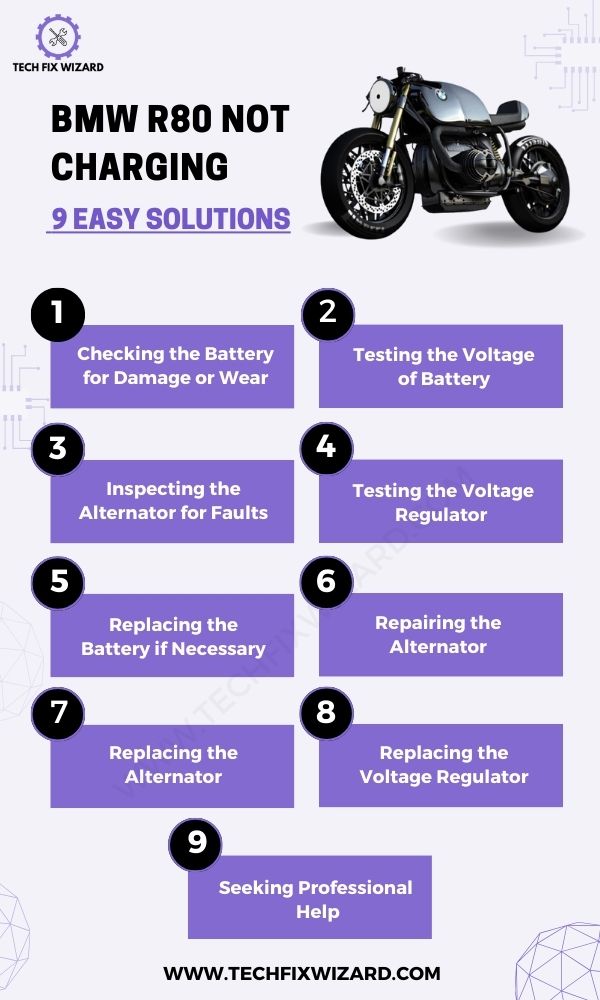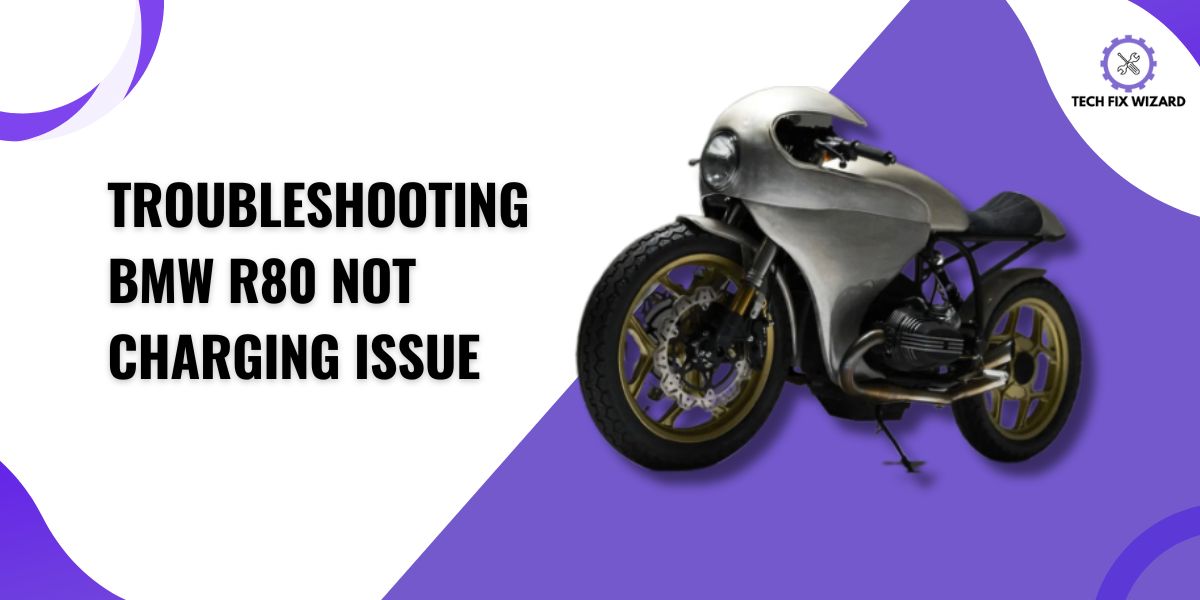If you own a BMW R80, you know that it’s a powerful machine that can take you on some incredible journeys.
But what happens when you face a BMW R80 Not Charging issue?
It can be frustrating and worrisome, but don’t worry – there are steps you can take to get your bike back up and running at full capacity.
In this article, we’ll guide you through the process of fixing your BMW R80 when it’s not charging correctly.
Contents
- 1 Understanding the Charging System of Your BMW R80
- 2 Troubleshooting BMW R80 Not Charging – 9 Steps
- 3 1. Checking the Battery for Damage or Wear
- 4 2. Testing the Voltage of Your Battery
- 5 3. Inspecting the Alternator for Faults
- 6 4. Testing the Voltage Regulator for Malfunctions
- 7 5. Replacing the Battery if Necessary
- 8 6. Repairing the Alternator
- 9 7. Replacing the Alternator
- 10 8. Replacing the Voltage Regulator
- 11 9. Seeking Professional Help
- 12 FAQs
- 13 1. Why is my BMW R80 not charging the battery?
- 14 2. How can I determine if the problem lies with the alternator?
- 15 3. What should be the ideal voltage output from the alternator?
- 16 4. How can I test the voltage regulator on my BMW R80?
- 17 5. What are the common symptoms of a defective voltage regulator?
- 18 6. How can I troubleshoot the charging system on my BMW R80?
- 19 7. Can a damaged battery cause charging problems?
- 20 8. Is it safe to ride my BMW R80 when the battery is not charging?
- 21 9. Can I replace the alternator on my own?
- 22 10. How often should the charging system be inspected on the BMW R80?
- 23 11. What should I do if I suspect a charging problem while on the road?
- 24 12. How much does it cost to fix a charging problem on a BMW R80?
- 25 Official References & Resources
Understanding the Charging System of Your BMW R80
If your BMW R80 is having charging issues, it’s important to understand how the system works so you can visualize the problem and find a solution.
The charging system of your motorcycle consists of three main components:
- Battery,
- Alternator
- Regulator/Rectifier.
The battery stores electrical energy that powers your bike’s lights and other accessories when the engine isn’t running. When you start the engine, the alternator generates electricity that recharges the battery and powers these accessories while keeping your bike running.
Meanwhile, the regulator/rectifier ensures that this electrical current stays at a constant voltage to protect sensitive electronics from damage.
One common issue with the BMW R80s is a failure in one or more of these components. A dead battery may not hold a charge even after being jumped or replaced with a new one.
An alternator that doesn’t spin properly may not generate enough electricity to recharge the battery while riding. A faulty regulator/rectifier may allow too much or too little voltage to flow through your bike’s electrical system, resulting in blown fuses or fried wires.

Troubleshooting BMW R80 Not Charging – 9 Steps
Troubleshooting the BMW R80 not charging issue revolves around inspecting the 3 major components mentioned above. Let’s inspect them one by one to reach the root cause of the problem.
1. Checking the Battery for Damage or Wear
First, take a look at your battery and see if there’s any visible damage or wear that could be causing the issue.
- Start by visually inspecting the battery for any visible signs of damage.
- Look for cracks, leaks, or bulges on the battery casing.
- If you notice any of these issues, it’s a clear indication that the battery needs to be replaced.
- Examine the battery terminals for corrosion. Corroded terminals can disrupt the electrical connection and prevent proper charging.
- If you find corrosion, clean the terminals using a mixture of baking soda and water or a commercial terminal cleaner.
However, if the battery appears to be in good condition, move on to the next step.

Explore More: BMW Airhead Not Charging – 6 Troubleshooting Steps To Follow
2. Testing the Voltage of Your Battery
Next, use a voltmeter to test the voltage of your battery.
- Turn off the motorcycle’s engine and all electrical accessories.
- Connect the voltmeter’s positive (red) probe to the battery’s positive terminal (+) and the negative (black) probe to the negative terminal (-).
- Read the voltage displayed on the voltmeter.
A fully charged 12-volt battery should read around 12.6 volts when the engine is off.
If it reads less than this amount, try charging it with a trickle charger overnight and retest in the morning. If the voltage still reads low after charging, then you may need a new battery.
3. Inspecting the Alternator for Faults
Now it’s time to take a closer look at your alternator and see if it’s the culprit behind your BMW R80’s battery issues.
The first step is to check the wiring connections that run from the alternator to the battery. Make sure they are securely fastened and free from any corrosion or damage. If there are any issues, replace the damaged wires or clean off any corrosion before reconnecting them.
Next, use a multimeter to test the output of the alternator.
1) Preparation:
- Turn off the engine and disconnect the battery.
2) Locate the Alternator/Generator:
- Identify its position at the front of the engine.
3) Measuring AC Voltage Output:
- Set the multimeter to AC voltage mode.
- Connect probes to any two of the three-phase wires.
- Start the engine and read the AC voltage.
- Gradually increase RPM and observe stable voltage within the specified range.
Also Read: BMW R1200GS Not Charging – 5 Quick & Easy Steps To Follow
4. Testing the Voltage Regulator for Malfunctions
Now let’s take a closer look at how to test the voltage regulator for any malfunctions on your BMW R80.
For testing the voltage regulator/Rectifier follow the steps given in the table below:
| Step | Description |
|---|---|
| 1. | Start the motorcycle’s engine and let it idle. |
| 2. | Use a voltmeter set to DC voltage mode. |
| 3. | Locate the voltage regulator/rectifier (usually near the battery or under the seat). |
| 4. | Identify the three wires connected to the regulator/rectifier (usually yellow or white). |
| 5. | Connect the voltmeter’s positive (red) probe to one of the yellow or white wires. |
| 6. | Connect the voltmeter’s negative (black) probe to the motorcycle’s frame or ground. |
| 7. | Note the voltage reading displayed on the voltmeter. |
| 8. | Gradually increase the engine RPM while observing the voltmeter. |
| 9. | The voltage reading should increase steadily and stabilize within the manufacturer’s range. |
If you’re getting readings outside of this range or no reading at all, then there might be a malfunction with your voltage regulator.

5. Replacing the Battery if Necessary
To replace the battery if it’s not holding a charge on your BMW R80, you’ll need to gather a few tools and prepare to remove the seat and side panels.
- First, locate the battery compartment.
- Disconnect the negative cable from the battery.
- Next, use a wrench or socket set to loosen the bolts that hold the battery in place.
- Now you can lift out the old battery.
- Replacing an old or damaged battery with a new one is crucial for ensuring proper charging of your BMW R80’s electrical system.
6. Repairing the Alternator
To repair the alternator, first, remove it from the bike and take apart its components.
- Check for any damaged parts such as brushes or bearings that may need replacement.
- Clean all parts with a wire brush and replace any damaged ones with new parts.
- Reassemble everything and reinstall the alternator back onto your bike.
If repairing the alternator proves futile, then it must be replaced entirely.
Relevant Read: BMW R100 Not Charging – 6 Easy & Quick Steps To Try
7. Replacing the Alternator
Replacing the alternator on a BMW R80 requires careful attention to detail. Below is a step-by-step guide to help you through the process:
| Step | Description | |
|---|---|---|
| 1. | Disconnect the Battery | Disconnect the motorcycle’s battery for safety. |
| 2. | Remove Necessary Parts | Disassemble components obstructing alternator access. |
| 3. | Locate the Alternator | Identify the alternator’s location on the engine. |
| 4. | Loosen and Remove Mounting Bolts | Unscrew and remove the mounting bolts securing the alternator. |
| 5. | Extract the Alternator | Gently pull out the alternator from its housing. |
| 6. | Install the New Alternator | Place the new alternator in the housing and align it with the mounting points. |
| 7. | Reattach Mounting Bolts | Securely fasten the alternator with mounting bolts. |
| 8. | Reconnect the Battery | Reconnect the motorcycle’s battery after replacement. |
| 9. | Test the Charging System | Start the engine and measure voltage output at the battery terminals with a multimeter. |
8. Replacing the Voltage Regulator
By following the simple steps given below, you’ll be able to easily replace your BMW R80’s faulty voltage regulator with a new one, allowing for a more reliable electrical system and uninterrupted rides.
| Step | Description | |
|---|---|---|
| 1. | Locate the Voltage Regulator | The voltage regulator is usually located under the seat or inside a side panel.
Refer to your owner’s manual if you’re unsure where it is. |
| 2. | Disconnect the Battery | Before replacing any electrical components, always disconnect your battery first to avoid any potential electrical shock. |
| 3. | Remove and Replace the Old Voltage Regulator | Once you’ve located it, remove the old voltage regulator by unscrewing it from its mount and disconnecting any wiring harnesses attached to it.
Then, install the new one in its place and reattach all wiring connections. |
| 4. | Reconnect the Battery | Finally, reconnect your battery and start up your engine to test if everything is working correctly. |
9. Seeking Professional Help
If you have attempted all the troubleshooting steps and testing procedures for the charging system, and still cannot identify or resolve the issue, it may be time to seek professional help.
Professional mechanics have the expertise, knowledge, and diagnostic tools to pinpoint complex charging system problems and ensure accurate and efficient repairs.
Popular Reads:
- BMW F800GS Battery Not Charging – 7 Steps To Try
- BMW R65 Battery Not Charging – 7 Troubleshooting Steps
FAQs
1. Why is my BMW R80 not charging the battery?
A: Several factors could contribute to this issue, including a faulty alternator, voltage regulator, damaged wiring, or a worn-out battery.
2. How can I determine if the problem lies with the alternator?
A: Use a multimeter to check the voltage across the battery terminals while the engine is running. If the voltage remains around 12V or decreases, the alternator might be faulty.
3. What should be the ideal voltage output from the alternator?
A: The ideal voltage output should be around 13.5 to 14.5 volts when the engine is running at a moderate speed.
4. How can I test the voltage regulator on my BMW R80?
A: You can perform a simple test with a multimeter to check if the voltage regulator is working correctly and maintaining a steady voltage output.
5. What are the common symptoms of a defective voltage regulator?
A: Symptoms include overcharging or undercharging the battery, flickering headlights, and various electrical issues.
6. How can I troubleshoot the charging system on my BMW R80?
A: Start by inspecting the battery, connections, and fuses. Then, test the alternator, voltage regulator, and stator to identify the faulty component.
7. Can a damaged battery cause charging problems?
A: Yes, a worn-out or damaged battery may not hold a charge, affecting the charging system’s overall performance.
8. Is it safe to ride my BMW R80 when the battery is not charging?
A: Continuing to ride with a non-charging battery can lead to a drained battery, causing the motorcycle to stall or leave you stranded.
9. Can I replace the alternator on my own?
A: While it is possible to replace the alternator yourself, it requires mechanical expertise and proper tools. It is recommended to consult a professional mechanic.
10. How often should the charging system be inspected on the BMW R80?
A: Regular maintenance is crucial. It’s best to have the charging system inspected during routine service intervals or at the first sign of charging issues.
11. What should I do if I suspect a charging problem while on the road?
A: If you notice any signs of charging issues while riding, try to get to a safe location and call for assistance or a tow to avoid further damage.
12. How much does it cost to fix a charging problem on a BMW R80?
A: The cost of repairs can vary depending on the specific issue and whether you choose OEM or aftermarket parts. Contact a reputable motorcycle service center for an accurate estimate.
Official References & Resources
Our research for providing accurate information about BMW involved a thorough analysis of official resources, including the official BMW website owner’s manuals, technical specifications, and relevant support forums.
Our research and data gathering involved thorough analysis of the official websites, including:

John Paul is a tech enthusiast dedicated to troubleshooting. He is passionate about fixing glitches, simplifying complexities, and empowering others in the digital realm.

